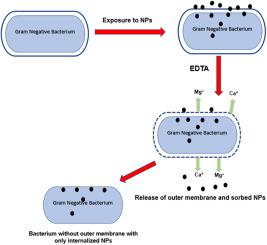当前位置:
X-MOL 学术
›
NanoImpact
›
论文详情
Our official English website, www.x-mol.net, welcomes your
feedback! (Note: you will need to create a separate account there.)
A novel method to estimate cellular internalization of nanoparticles into gram-negative bacteria: Non-lytic removal of outer membrane and cell wall
NanoImpact ( IF 4.7 ) Pub Date : 2021-01-01 , DOI: 10.1016/j.impact.2020.100283 Amjed Alabresm 1 , Alan W Decho 2 , Jamie Lead 3
NanoImpact ( IF 4.7 ) Pub Date : 2021-01-01 , DOI: 10.1016/j.impact.2020.100283 Amjed Alabresm 1 , Alan W Decho 2 , Jamie Lead 3
Affiliation

|
Abstract Bacteria efficiently take up small organic molecules and ions. However, the internalization of particulate forms, specifically nanoparticles (NPs) has been understudied and is a newly-emerging area of interest. However, determination of true cellular internalization is challenging owing to the difficulty of separating the aqueous phase from bacteria-associated NPs and, more importantly, of differentiating between internalized and NPs sorbed on bacteria surfaces. In this work, we developed and validated an extraction method which can operationally estimate internalization of metal NPs into Gram-negative bacteria. The outer cell membrane and cell wall, collectively called the periplasm, was successfully removed from bacteria using ethylenediaminetetraacetic acid (EDTA) at an optimized exposure period and concentration, without lysis of bacteria. This was followed by standard digestion and metal measurements. Verification of each step of the methodology was conducted by assessing both cellular and metal behavior. Specifically, the combined approaches of live/dead staining of bacteria, optical density measurements, transmission electron microscopy (TEM) and metal analyses of the supernatant indicated that the method operationally separated externally-sorbed NPs from those internalized actually localized within the bacterial cytoplasm. However, this new method is ideally used alongside other methods in a multi-method approach, to provide improved data quality. Therefore, it should be used with CSLM, FACS, TEM and other available methods.
中文翻译:

一种估计纳米颗粒细胞内化为革兰氏阴性菌的新方法:外膜和细胞壁的非溶解去除
摘要 细菌有效地吸收有机小分子和离子。然而,颗粒形式的内化,特别是纳米颗粒 (NPs) 的研究还不够深入,是一个新出现的令人感兴趣的领域。然而,由于难以将水相与细菌相关的 NP 分离,更重要的是,难以区分内化和吸附在细菌表面的 NP,因此确定真正的细胞内化具有挑战性。在这项工作中,我们开发并验证了一种提取方法,该方法可以在操作上估计金属 NPs 内化为革兰氏阴性细菌。使用乙二胺四乙酸 (EDTA) 在优化的暴露时间和浓度下,成功地从细菌中去除了外细胞膜和细胞壁,统称为周质,不裂解细菌。随后进行标准消解和金属测量。通过评估细胞和金属行为来验证该方法的每个步骤。具体来说,细菌的活/死染色、光密度测量、透射电子显微镜 (TEM) 和上清液的金属分析的组合方法表明,该方法在操作上将外部吸附的 NP 与实际定位在细菌细胞质内的内部分离。但是,这种新方法可以与多方法方法中的其他方法一起理想地使用,以提供更高的数据质量。因此,它应该与 CSLM、FACS、TEM 和其他可用方法一起使用。通过评估细胞和金属行为来验证该方法的每个步骤。具体来说,细菌的活/死染色、光密度测量、透射电子显微镜 (TEM) 和上清液的金属分析的组合方法表明,该方法在操作上将外部吸附的 NP 与实际定位在细菌细胞质内的内部分离。但是,这种新方法可以与多方法方法中的其他方法一起理想地使用,以提供更高的数据质量。因此,它应该与 CSLM、FACS、TEM 和其他可用方法一起使用。通过评估细胞和金属行为来验证该方法的每个步骤。具体来说,细菌的活/死染色、光密度测量、透射电子显微镜 (TEM) 和上清液的金属分析的组合方法表明,该方法在操作上将外部吸附的 NP 与实际定位在细菌细胞质内的内部分离。但是,这种新方法可以与多方法方法中的其他方法一起理想地使用,以提供更高的数据质量。因此,它应该与 CSLM、FACS、TEM 和其他可用方法一起使用。上清液的透射电子显微镜 (TEM) 和金属分析表明,该方法可操作地将外部吸附的 NP 与实际位于细菌细胞质内的内化 NP 分开。但是,这种新方法可以与多方法方法中的其他方法一起理想地使用,以提供更高的数据质量。因此,它应该与 CSLM、FACS、TEM 和其他可用方法一起使用。上清液的透射电子显微镜 (TEM) 和金属分析表明,该方法可操作地将外部吸附的 NP 与实际位于细菌细胞质内的内化 NP 分开。但是,这种新方法可以与多方法方法中的其他方法一起理想地使用,以提供更高的数据质量。因此,它应该与 CSLM、FACS、TEM 和其他可用方法一起使用。
更新日期:2021-01-01
中文翻译:

一种估计纳米颗粒细胞内化为革兰氏阴性菌的新方法:外膜和细胞壁的非溶解去除
摘要 细菌有效地吸收有机小分子和离子。然而,颗粒形式的内化,特别是纳米颗粒 (NPs) 的研究还不够深入,是一个新出现的令人感兴趣的领域。然而,由于难以将水相与细菌相关的 NP 分离,更重要的是,难以区分内化和吸附在细菌表面的 NP,因此确定真正的细胞内化具有挑战性。在这项工作中,我们开发并验证了一种提取方法,该方法可以在操作上估计金属 NPs 内化为革兰氏阴性细菌。使用乙二胺四乙酸 (EDTA) 在优化的暴露时间和浓度下,成功地从细菌中去除了外细胞膜和细胞壁,统称为周质,不裂解细菌。随后进行标准消解和金属测量。通过评估细胞和金属行为来验证该方法的每个步骤。具体来说,细菌的活/死染色、光密度测量、透射电子显微镜 (TEM) 和上清液的金属分析的组合方法表明,该方法在操作上将外部吸附的 NP 与实际定位在细菌细胞质内的内部分离。但是,这种新方法可以与多方法方法中的其他方法一起理想地使用,以提供更高的数据质量。因此,它应该与 CSLM、FACS、TEM 和其他可用方法一起使用。通过评估细胞和金属行为来验证该方法的每个步骤。具体来说,细菌的活/死染色、光密度测量、透射电子显微镜 (TEM) 和上清液的金属分析的组合方法表明,该方法在操作上将外部吸附的 NP 与实际定位在细菌细胞质内的内部分离。但是,这种新方法可以与多方法方法中的其他方法一起理想地使用,以提供更高的数据质量。因此,它应该与 CSLM、FACS、TEM 和其他可用方法一起使用。通过评估细胞和金属行为来验证该方法的每个步骤。具体来说,细菌的活/死染色、光密度测量、透射电子显微镜 (TEM) 和上清液的金属分析的组合方法表明,该方法在操作上将外部吸附的 NP 与实际定位在细菌细胞质内的内部分离。但是,这种新方法可以与多方法方法中的其他方法一起理想地使用,以提供更高的数据质量。因此,它应该与 CSLM、FACS、TEM 和其他可用方法一起使用。上清液的透射电子显微镜 (TEM) 和金属分析表明,该方法可操作地将外部吸附的 NP 与实际位于细菌细胞质内的内化 NP 分开。但是,这种新方法可以与多方法方法中的其他方法一起理想地使用,以提供更高的数据质量。因此,它应该与 CSLM、FACS、TEM 和其他可用方法一起使用。上清液的透射电子显微镜 (TEM) 和金属分析表明,该方法可操作地将外部吸附的 NP 与实际位于细菌细胞质内的内化 NP 分开。但是,这种新方法可以与多方法方法中的其他方法一起理想地使用,以提供更高的数据质量。因此,它应该与 CSLM、FACS、TEM 和其他可用方法一起使用。











































 京公网安备 11010802027423号
京公网安备 11010802027423号